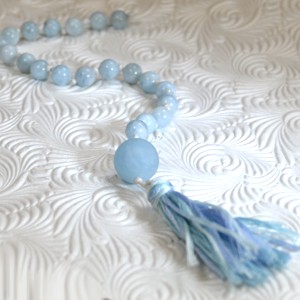Buddhist Beads: History and Use of Prayer Beads
| Gemstone Articles | |||||
|
|
Buddhist Beads: History and Use of Prayer BeadsOriginating in India about 500 B.C., Buddhism reached China in the first century A.D., Korea about the beginning of the fourth century, Japan the sixth, and Tibet the eighth. As Buddhism became the established religion in these countries, it was influenced by the diverse cultures with which it came into contact. |
||||
|
|
Unlimited tolerance is an essential principle of Buddhism, a concept reflected in the various forms and materials of its prayer beads. This cane be seen, for example, by comparing Tibetan Buddhist beads with those from Japan. Differences exist in the elaboration of form, the number and types of pendants and tassels, the dividing beads and materials – the Japanese, regardless of their social status, have tended to use wood, while wealthy Tibetans preferred Amber and Coral or human bone. Buddhism adopted rosaries from the Hindus. The rosary, an important part of a Buddhist monks attire, usually consists of 108 smooth beads, corresponding to the number of mental conditions or sinful desires that can be overcome by the recitation with the beads. Although monks use full chains of 108 beads, rosaries carried by lay people often consists of only thirty of forty beads. Tibetan Buddhist Prayer Beads Malas are also known as japa malas or as the Buddhist rosary. While Buddhist rosaries commonly have 108 beads, there are also wrist malas with 16 to 19 beads. The japa mala is traditionally used in Tibetan Buddhism and in Hinduism. Prayer beads are used to count mantras. When using the japa mala, your fingers pass over one prayer bead for each time you recite the mantra. Tibetan Buddhist prayer beads come from Hindu prayer beads, and in both religions the number 108 is important. Favored beads are from the seed of the sacred bo tree, a species of fig (Ficus religiosa). The use of beads for meditation and attainment and attainment of a mystical state through repetition of prayer has its widest application in Buddhism, particularly in the Himalayan region, where they are still a familiar part of life. In old Tibet, nearly everyone carried or wore prayer beads of wood, shell, amber, semiprecious or precious stones. The materials differed according to the owners taste and wealth, and depended too on the devotees sect and the deity worshipped. The most highly prized beads were made from the bones of a Lama. In old Tibetan rosaries, three beads of different sizes and materials were used to divide the full rosary of 108 round or disk beads into four groups of twenty-seven each. At the point where the two ends of the string came together, three large retaining beads were included to indicate the completion of a round or circuit of prayer. These last beads symbolize the triad of Buddha, the doctrine and the community. Attached to the main string were usually two strands of of ten smaller beads. Known as the number keepers or counters, these act like a minature abacus, keeping track of the number of times the user recites his prayer or mantra. The counter strings generally terminate with two small pendants, called the djore and drilbu. The djore (a representation of the conventionalized thunderbolt of Indra) is the single circuit string, while the drilbu (a tiny bell) marks every ten repetitions. In addition to these conventions, it is common to find personal odds and ends, such as tweezers or keys, attached to the rosaries. Prayer beads were less widespread in China. Under Manchu rule (1644-1912), however, Buddhist prayer beads, modeled after those from Tibet, became fashionable with the ruling hierarchy and quite elaborate. Called court chains, they were used in China primarily for status symbols rather than prayer. In Korea, where Buddhism was the official state religion until banned by the Yi dynasty (1392-1910), rosaries were quite an important part of religious rituals. Korean rosaries typically have 110 beads, whereas most Buddhist rosaries use 108. The two extra beads are large: one is decorated with swastika and located at the beginning of the strand; the other is plain and placed in the middle. A devotional treatise entitled the Classic of the Rosary is displayed as a poster on the walls of the Korean Buddhist temples. The Classic shows a rosary and explains its numerous uses. Among the Japanese, prayer beads were also an important component of both social and religious life. The beads were carried by monks and lay citizens to funerals and other ceremonial events. All teahouses had a hook on the wall for hanging the beads; an important or unusual set gave prestige to the teahouse. The Buddhist rosary took on unique forms in Japan, with different sects exhibiting various numbers and arrangements of beads. The most widely used was the shozoiki jiudzu, a strand of 112 beads. Jui-dzu shops, often located at pilgrimage stops, advertised their sacred wares by hanging huge wooden rosaries outside the store. A set of prayer beads that has been blessed over the incense of smoke of a respected temple was highly valued by its owner. Wood was the preferred material for Japanese Buddhist rosaries. Cherry, rose, plum, carved and smoothed peach, ebony and mahogany were all used. Walnut shells, Cherry pits, and the nuts of the bead tree (Melia azedarach) were also popular. There are various gemstones used in Buddhist prayer. They include: Amazonite, Amber,Azurite, Rhodonite,
|
||||

